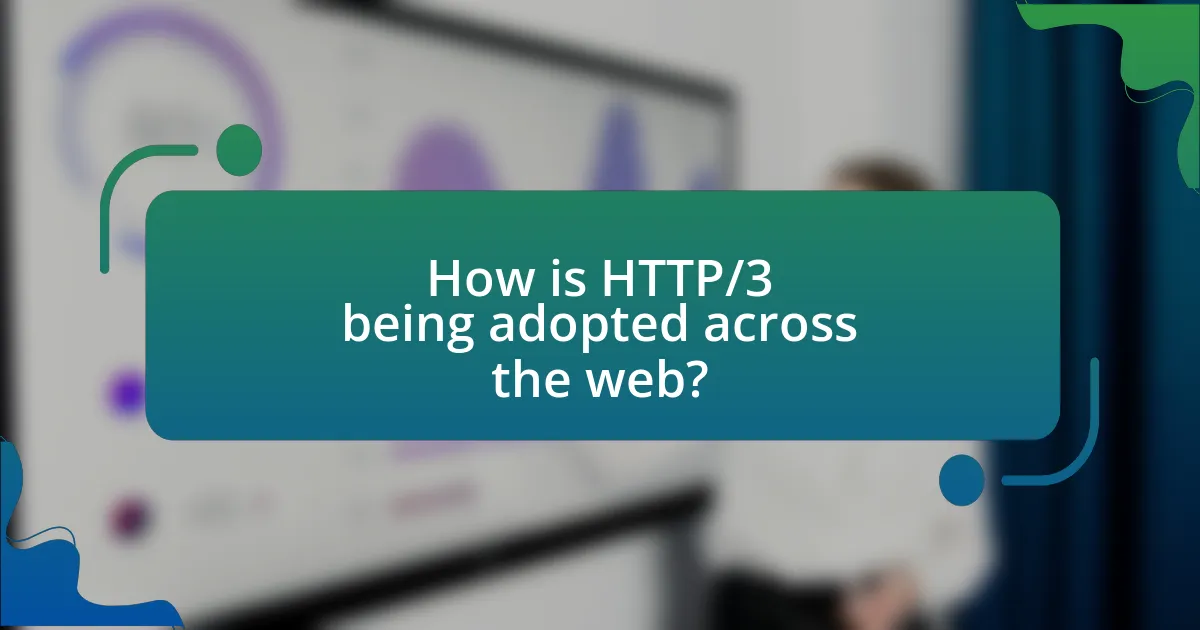HTTP/3 is the latest iteration of the Hypertext Transfer Protocol, utilizing QUIC as its transport layer to enhance web performance and security. This protocol significantly reduces latency, improves connection reliability, and accelerates data transfer speeds, particularly in challenging network conditions. Key features of HTTP/3 include multiplexing, connection migration, and built-in encryption, which collectively enhance user experience and security. The article explores the differences between HTTP/3 and its predecessors, its adoption across major platforms, the advantages it offers, and the challenges organizations face during implementation. Additionally, it discusses the impact of HTTP/3 on user experience, particularly in mobile environments and real-time applications, while outlining best practices for a smooth transition to this advanced protocol.

What is HTTP/3 and why is it significant in modern web networking?
HTTP/3 is the latest version of the Hypertext Transfer Protocol, designed to improve web performance and security by utilizing QUIC (Quick UDP Internet Connections) as its transport layer. This protocol is significant in modern web networking because it reduces latency, enhances connection reliability, and improves data transfer speeds, particularly in environments with high packet loss or variable network conditions. For instance, HTTP/3’s ability to establish connections faster than its predecessors—by eliminating the need for multiple round trips—can lead to a more responsive user experience, which is crucial for applications like video streaming and online gaming. Additionally, QUIC’s built-in encryption enhances security, making it a vital advancement in the ongoing evolution of web technologies.
How does HTTP/3 differ from its predecessors?
HTTP/3 differs from its predecessors primarily by utilizing QUIC as its transport protocol instead of TCP. This shift allows for reduced latency and improved performance, particularly in scenarios with high packet loss, as QUIC incorporates features like multiplexing and connection migration directly into the protocol. Additionally, HTTP/3 eliminates head-of-line blocking, a limitation present in HTTP/2 over TCP, enhancing the efficiency of data transmission. These advancements are supported by the fact that QUIC was designed to address the shortcomings of TCP, leading to faster and more reliable web experiences.
What are the key features that distinguish HTTP/3?
HTTP/3 is distinguished by its use of QUIC as the transport protocol, which enhances performance and security. QUIC, developed by Google, combines the features of TCP and TLS, reducing latency through multiplexing and eliminating head-of-line blocking. Additionally, HTTP/3 supports connection migration, allowing seamless transitions between networks without dropping connections. These features collectively improve loading times and user experience, particularly in mobile environments where network conditions frequently change.
How does the underlying protocol QUIC enhance HTTP/3?
The underlying protocol QUIC enhances HTTP/3 by providing reduced latency and improved connection reliability. QUIC achieves this through features such as multiplexing streams without head-of-line blocking, which allows multiple requests and responses to be processed simultaneously. Additionally, QUIC incorporates built-in encryption and faster connection establishment, reducing the time required for secure communication. These enhancements lead to a more efficient and responsive web experience, as evidenced by studies showing that QUIC can significantly decrease page load times compared to previous protocols like TCP.
What are the main advantages of using HTTP/3?
The main advantages of using HTTP/3 include improved performance, reduced latency, and enhanced security. HTTP/3 utilizes QUIC, a transport protocol that combines the features of TCP and UDP, allowing for faster connection establishment and better handling of packet loss. This results in quicker page loads and a smoother user experience, particularly in mobile and high-latency environments. Additionally, HTTP/3’s built-in encryption enhances security by default, making it more resilient against various types of attacks compared to its predecessors.
How does HTTP/3 improve latency and performance?
HTTP/3 improves latency and performance primarily through the use of QUIC, a transport protocol that reduces connection establishment time and minimizes latency. QUIC combines the features of TCP and TLS, allowing for faster handshakes and enabling multiplexing of streams without head-of-line blocking, which is a limitation in previous HTTP versions. This results in quicker data transmission and improved responsiveness, especially in high-latency environments. Additionally, QUIC’s ability to maintain connections even when network conditions change enhances overall performance, making HTTP/3 more efficient for modern web applications.
What security enhancements does HTTP/3 provide?
HTTP/3 provides several security enhancements, primarily through its use of QUIC, which integrates TLS 1.3 for encryption. This integration ensures that all data transmitted is encrypted by default, reducing the risk of eavesdropping and man-in-the-middle attacks. Additionally, QUIC’s connection establishment process is faster and more secure, as it combines the handshake for establishing a connection and negotiating encryption parameters, minimizing exposure to potential attacks during the handshake phase. Furthermore, HTTP/3’s support for improved authentication mechanisms enhances the overall security posture of web communications.

How is HTTP/3 being adopted across the web?
HTTP/3 is being adopted across the web through increasing support from major browsers and web servers, as well as the integration of QUIC protocol, which underpins HTTP/3. As of 2023, browsers like Chrome, Firefox, and Safari have implemented HTTP/3, enabling faster and more efficient data transmission. Additionally, prominent web servers such as NGINX and Cloudflare have adopted HTTP/3, facilitating its deployment for a significant portion of internet traffic. According to a report by Akamai, as of early 2023, over 30% of websites were utilizing HTTP/3, indicating a rapid growth in its adoption. This trend reflects a broader shift towards improving web performance and user experience.
What are the current trends in HTTP/3 implementation?
Current trends in HTTP/3 implementation include increased adoption by major web browsers and platforms, with Google Chrome, Mozilla Firefox, and Microsoft Edge supporting it as of 2023. Additionally, content delivery networks (CDNs) like Cloudflare and Akamai are integrating HTTP/3 to enhance performance and reduce latency. The use of QUIC, the underlying transport protocol for HTTP/3, is also gaining traction due to its ability to improve connection speeds and security. According to a report by the Internet Engineering Task Force (IETF), as of late 2023, over 30% of websites are utilizing HTTP/3, reflecting a significant shift towards this protocol in modern web networking.
Which major platforms and services have adopted HTTP/3?
Major platforms and services that have adopted HTTP/3 include Google, Facebook, Cloudflare, and Microsoft. Google implemented HTTP/3 in its Chrome browser and Google Cloud services, enhancing performance and security. Facebook has integrated HTTP/3 into its services to improve user experience. Cloudflare supports HTTP/3 across its content delivery network, optimizing speed for its clients. Microsoft has also adopted HTTP/3 in its Azure cloud services, facilitating faster data transfer. These implementations demonstrate a significant shift towards the adoption of HTTP/3 in modern web networking.
How are developers preparing for the transition to HTTP/3?
Developers are preparing for the transition to HTTP/3 by adopting QUIC, the underlying transport protocol, and updating their server configurations to support it. Many developers are implementing libraries and frameworks that facilitate QUIC integration, such as nghttp3 and quiche, which provide essential tools for building HTTP/3 applications. Additionally, developers are testing their applications in environments that simulate HTTP/3 traffic to identify potential issues and optimize performance. According to a survey by Cloudflare, as of 2023, over 50% of websites are already serving content over HTTP/3, indicating a significant shift towards this new protocol.
What challenges are associated with the adoption of HTTP/3?
The challenges associated with the adoption of HTTP/3 include compatibility issues, performance variability, and the need for infrastructure upgrades. Compatibility issues arise because not all existing web servers and clients support HTTP/3, which is based on QUIC, leading to potential connectivity problems. Performance variability can occur due to the reliance on UDP, which may result in inconsistent performance across different network conditions. Additionally, the widespread adoption of HTTP/3 necessitates significant upgrades to network infrastructure, including routers and firewalls, which may not be equipped to handle QUIC traffic effectively. These challenges can hinder the seamless transition from HTTP/2 to HTTP/3, impacting overall web performance and user experience.
What technical hurdles do organizations face when implementing HTTP/3?
Organizations face several technical hurdles when implementing HTTP/3, primarily due to its reliance on the QUIC transport protocol. One significant challenge is the need for updated infrastructure, as many existing servers and network devices do not support QUIC, requiring organizations to invest in new hardware or software solutions. Additionally, compatibility issues arise with older browsers and clients that may not support HTTP/3, limiting its adoption.
Another hurdle is the complexity of managing and configuring QUIC, which differs from traditional TCP-based protocols, necessitating specialized knowledge and training for IT staff. Furthermore, organizations must address potential security concerns, as the implementation of new protocols can introduce vulnerabilities if not properly managed. These factors collectively hinder the seamless transition to HTTP/3 for many organizations.
How do compatibility issues with existing infrastructure affect HTTP/3 adoption?
Compatibility issues with existing infrastructure significantly hinder HTTP/3 adoption. Many organizations rely on legacy systems and protocols that do not support the QUIC transport layer, which is fundamental to HTTP/3. For instance, network devices such as firewalls and load balancers may not recognize or properly handle QUIC traffic, leading to connectivity problems and degraded performance. According to a study by Cloudflare, approximately 30% of users experience issues with HTTP/3 due to such infrastructure limitations. This lack of compatibility creates resistance among businesses to transition to HTTP/3, as they must invest in upgrading or replacing their existing infrastructure to fully leverage the benefits of the new protocol.

What impact does HTTP/3 have on user experience and web performance?
HTTP/3 significantly enhances user experience and web performance by reducing latency and improving connection reliability. This protocol, built on QUIC, allows for faster data transmission through features like multiplexing and connection establishment without the need for multiple round trips. Studies indicate that HTTP/3 can reduce loading times by up to 30% compared to HTTP/2, particularly in high-latency environments. Additionally, its ability to maintain connections even in fluctuating network conditions leads to a smoother browsing experience, minimizing disruptions and buffering.
How does HTTP/3 influence page load times?
HTTP/3 significantly reduces page load times by utilizing QUIC, a transport protocol that minimizes latency through features like multiplexing and connection establishment. Unlike its predecessors, HTTP/3 allows multiple streams of data to be sent simultaneously over a single connection, which prevents head-of-line blocking and accelerates the loading of resources. Additionally, QUIC’s ability to establish connections faster than TCP, often in just one round trip, further enhances speed. Studies indicate that websites using HTTP/3 can experience load time improvements of up to 30% compared to those using HTTP/2, particularly in high-latency environments.
What role does HTTP/3 play in mobile web performance?
HTTP/3 significantly enhances mobile web performance by utilizing QUIC, a transport protocol that reduces latency and improves connection speeds. QUIC’s ability to establish connections faster than previous protocols, such as TCP, leads to quicker page loads and a smoother user experience on mobile devices. Additionally, HTTP/3’s multiplexing feature allows multiple requests to be sent simultaneously over a single connection, minimizing delays caused by head-of-line blocking, which is common in HTTP/2. This results in more efficient use of network resources, particularly in environments with variable connectivity, such as mobile networks.
How does HTTP/3 affect streaming and real-time applications?
HTTP/3 significantly enhances streaming and real-time applications by utilizing QUIC, which reduces latency and improves connection reliability. QUIC’s ability to establish connections faster than previous protocols, such as TCP, allows for quicker data transmission, which is crucial for real-time interactions like video conferencing and online gaming. Additionally, HTTP/3’s multiplexing feature prevents head-of-line blocking, ensuring that packet loss in one stream does not affect others, thereby maintaining a smooth user experience during streaming. These improvements are supported by studies showing that QUIC can reduce latency by up to 30% compared to TCP, making it particularly beneficial for applications requiring immediate data delivery.
What best practices should be followed when implementing HTTP/3?
When implementing HTTP/3, it is essential to prioritize the use of QUIC as the transport protocol, which enhances performance through reduced latency and improved connection establishment times. Additionally, ensuring compatibility with existing infrastructure is crucial; this includes updating load balancers and firewalls to support QUIC traffic. Implementing proper server configurations, such as enabling ALPN (Application-Layer Protocol Negotiation) for HTTP/3, is also necessary to facilitate protocol negotiation. Furthermore, monitoring and analyzing performance metrics post-implementation can help identify areas for optimization. These practices are supported by the fact that HTTP/3’s design aims to improve user experience by addressing limitations found in previous versions, as evidenced by its adoption in major browsers and platforms.
How can organizations ensure a smooth transition to HTTP/3?
Organizations can ensure a smooth transition to HTTP/3 by implementing a phased rollout strategy that includes thorough testing, staff training, and updating infrastructure. A phased rollout allows organizations to gradually adopt HTTP/3, minimizing disruptions while identifying and resolving potential issues early. Testing in a controlled environment helps ensure compatibility with existing systems and applications, while staff training equips teams with the necessary knowledge to manage the new protocol effectively. Additionally, updating network infrastructure, such as load balancers and firewalls, to support QUIC (the underlying transport protocol for HTTP/3) is crucial for seamless integration. These steps are supported by industry best practices, as seen in successful transitions by major tech companies that have adopted HTTP/3, demonstrating the effectiveness of a structured approach.
What monitoring tools are available for assessing HTTP/3 performance?
Monitoring tools available for assessing HTTP/3 performance include Wireshark, which captures and analyzes network traffic, and Google Chrome’s built-in DevTools, which provides insights into network performance metrics. Additionally, tools like Fiddler and cURL can be used to test and monitor HTTP/3 connections. These tools are effective because they support QUIC, the underlying protocol for HTTP/3, allowing for detailed analysis of connection establishment, latency, and throughput.



